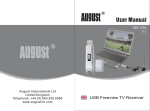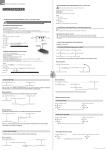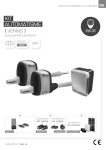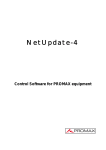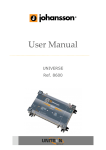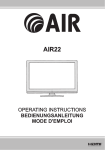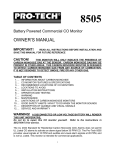Download Switching over to digital TV
Transcript
Switching over to digital TV A guide for tenants and leaseholders www.homesforharingey.org Switching over to digital TV Contents Section Page 1 Why are you replacing the communal TV aerial system in our block of flats? .............. 3 2 What choice of system will we have? ........................................................................ 4 3 How will you consult me? ........................................................................................ 4 4 How much will tenants and leaseholders have to pay towards the new system? ............ 5 5 Can I apply to install my own satellite dish? .............................................................. 6 6 What will happen if I put up a dish without getting permission? .................................. 7 7 Why is Homes for Haringey going to remove residents’ dishes? .................................. 7 8 What will the satellite system provide? ...................................................................... 8 9 Which additional channels will I be able to receive? ................................................ 8 1 0 Who does what? .................................................................................................... 8 1 1 Will the contractor let me know when they are coming to do the work in my flat?........11 1 2 Where will the contractor install the socket box? ......................................................12 1 3 What if I want to have sockets installed in more than one room?................................12 1 4 Will my current TV set work with the new system or do I have to buy a new one? ......13 1 5 Will I have to adjust my TV, Video, DVD and so on when the new system is installed? 13 1 6 I already have digital TV – do I have to pay for the new communal TV service? ..........13 1 7 What will I need for the digital switchover in 2012?..................................................14 1 8 Can my TV be converted? ......................................................................................14 1 9 Will recorders still work? ........................................................................................14 2 0 When do I re-tune my set-top box?..........................................................................14 2 1 What help is available for people who have problems switching to digital TV?............16 2 2 Glossary ..............................................................................................................17 2 Homes for Haringey 1. Why are you replacing the communal TV aerial system in our block of flats? The Government has set the end of 2012 as the deadline for the switchover from analogue to digital TV. All TV broadcasts after this date will be digital. The communal aerials in most of the Council’s blocks of flats will not receive digital TV or the reception will either be poor or very unreliable. They are also generally coming to the end of their useful life spans. For these reasons all the communal TV systems will have to be replaced by the end of 2012. Furthermore in order to give residents a wide range of free channels and a good choice of subscription services it is necessary to install systems with satellite reception. A g u i d e f o r t e n a n t s a nd l e a s e h o l d e r s We will only carry out the work to those blocks which currently have communal TV aerials. So to be ready for the digital switchover, Homes for Haringey has appointed contractors to replace all the communal aerial systems in the blocks which have them. At the same time the Council has decided to give residents a say in the upgrading of the system in their building – please see the next section. If you have any questions not answered in this booklet please phone us on 0800 195 3404 or 020 8489 5611 (cheaper from a mobile), or visit www.homesforharingey.org 3 Switching over to digital TV 2.. What choice of system will we have? Residents in each building will be asked to choose which of the two options for the communal aerial/satellite systems they wold prefer to be installed in the block. These options will be as follows: a) Option 1: the fully integrated reception system (IRS)consisting of: i. Freeview TV and DAB radio ii. satellite services including: • Sky Plus/High Definition and Freesat, • Hotbird • Turksat. b) Option 2: integrated reception system (IRS)consisting of: i. Freeview TV and DAB radio ii. satellite services including Sky Plus/High Definition and Freesat See Sections 8 and 9 for some details of the different services. See Section 4 for how much it will cost. 3 . How will you consult me? You will receive a form giving you two options. We are sending one form to every home. Since there is only one form for each property, you will have to agree as a household which option you prefer. You must return the form in the prepaid envelope enclosed with it. If y ou h ave an y q u e s t i o n s y o u c a n a t t e n d t h e d r o p - i n s e s si o n f o r y o u r a r e a b e f o r e y o u c o m p l e t e y o ur f o r m . Residents’ choices will be kept confidential. Only one type of system can be installed in each building, so if most of the residents choose Option 2, then no one will be able to receive the Turksat or Hotbird channels. It will 4 not be possible for some residents to have Option 1 and other resident to have Option 2 in the same block. In some estates the communal TV system serves more than one building, where they are close together. In these cases the decision as to which option will be installed will be made on the basis of the choices expressed by all the buildings using the system. If you are a leaseholder and you are subletting you should note that only you will be able to tell us which system you prefer – your sublessees will not. You must let them know what is happening and tell them they must allow the contractors into your property to install the new socket box. Please remember that we will not allow residents’ satellite dishes on blocks so the type of system the Council installs in the property will be final. In addition it will be important to let future owners or tenants know what television services they can receive. Drop in sessions. At the same time we send you the form, we will invite you to a drop-in session in your area. The purpose of the dropin session will be to answer any questions you may have about the two options or about the work. Each session will normally be attended by a Project Manager, an Engineer, a Tenancy Management Officer, a Resident Liaison Officer and a representative from the contractor who we have chosen to do the work. The date for the return of the form will be shortly after the drop-in session. We will let you know what system we will install after the closing date to return forms has passed. Section 20 Notice. If you are a leaseholder you will receive a Section 20 Notice at least a month before the work starts. This will contain a description of the proposed work, an estimate of its cost and it will inform you that Homes for Haringey you have the right to make observations in writing for a period of 30 days from the date of the notice. We must send you this legal notice since it is required under section 20 of the Landlord and Tenant Act 1985. 4. How much will tenants and leaseholders have to pay towards the new system? The Council has decided to cap the charges at £400. The charges will vary depending on the size of the building and which option all the residents in your building choose. The maximum (shown capped at £400) and minimum charges are shown in the table below: Leaseholders will have to pay a one-off charge as shown in the table below. The actual cost will only be known when the work is carried out. Obviously the cost of Option 1 will be a bit more than that for Option 2, but in both cases the charge to leaseholders will be capped at (limited to) £400. Block with less than 25 flats Block with between 25 and 50 flats Block with over 50 flats Option 1 £391 - £400 £381 - £400 £372 - £400 Option 2 £350 - £400 £333 - £400 £322 - £400 Tenants will have to pay through their service charges. You will not have to pay anymore than 77 pence per week over 10 years. (You will not have to pay more than £400 in total.) If you have already received an invoice for more than £400 for a digital installation you will receive a credit to your account for the additional amount. You will only have to start paying this after the work to install the new system has been carried out in your building. If you receive housing benefit the charge will automatically be advised to the Council’s Housing Benefit team who will in turn advise individual tenants. The charge is eligible for housing benefit. A g u i d e f o r t e n a n t s a nd l e a s e h o l d e r s 5 Switching over to digital TV 5 . Can I apply to install my own satellite dish? The Council has decided that individual dishes will not be allowed in a building with a new communal system. However, if we do not plan to install a new communal TV system in your building, we may allow you to install your own dish. We generally do not plan to install communal systems in very small blocks of flats and in houses which have been converted into several flats. If you wish to put one up you must first obtain our permission ( landlor d’s c on se n t ) and p l a n n i n g p er m i ss i o n: Landlord’s Consent A tenant or leaseholder must always apply to us to get permission to install a satellite dish if they have no communal system. You will need to speak to the Tenancy Management Officer for your area. The following rules will apply. 6 Tenants and leaseholders must get our permission in writing before putting up anything on the outside of the building, including TV aerials, satellite dishes and so on. Both the tenancy agreement and the lease state you must get the Council’s permission (through us) before you put anything on the outside of the building. Planning permission If we agree to you putting up a dish outside your flat you must contact the Council’s Planning Department to find out if planning permission is required. If planning permission is not necessary a letter must be obtained from the Council’s Planning Department to confirm that this is the case. Planning permission is usually required for medium and high rise buildings and is always required in a conservation area. To find out how the planning rules apply to your building you should speak to the Council’s Planning Department – phone 020 8489 0000. Homes for Haringey Retrospective permission If there is no communal aerial system in the building and a resident has installed their own aerial or dish, we may still be prepared to grant permission. However the resident will have to find out from the Planning Department whether planning permission is required. We will not allow a resident to put up a dish just because they want to have additional channels which are not provided by the communal system. Please consider this carefully when making your choice of aerial system. cost to the building and residents will have to pay towards the cost as part of their service charges. 7 . Why is Homes for Haringey going to remove residents’ dishes? Residents’ dishes and aerials can cause a lot of problems: • They cause damage to the outside of the building including the roof and the walls 6. What will happen if I put • up a dish without getting permission? Dishes can shade other residents’ windows, block their view or cause wind noise • Any resident who puts up a satellite dish or TV aerial in future without our permission will have to pay all the costs for its removal The brackets and other parts of the dishes (and cables) are likely to become insecure over time which will make them a health and safety hazard to passers-by • People often do not maintain their dishes or aerials and when they move away the dishes may not be used by the new tenants or leaseholders • The problems arising from individual dishes on the roofs and on the outside of the building are likely to increase in future, if the Council does not stop them from being installed. This will happen as more of them become disused and they deteriorate on account of the weather • • However if you have put up a dish before we installed the new communal TV system in your building, we will not charge you for its removal. When our contractors come to do the work we will ask them to remove any satellite dishes or aerials residents have put up on the building • If you put up your own dish after we have installed a new system on your building, we will write to you and ask you to remove it right away • If you don’t arrange for it to be removed, we will pay a contractor to do it and charge you all our costs for doing so • There may be cases when a resident puts up a dish without our permission and we are unable to charge them for the cost of removal (for instance because they have moved away). We will then charge the A g u i d e f o r t e n a n t s a nd l e a s e h o l d e r s 7 Switching over to digital TV 8 . What will the satellite system provide? Option 1 uses three communal satellite dishes to provide a wider range of services. Each satellite provides different services, which are described below. In order to receive the channels you must generally have a special receiver (box) (unless your television set already has it inbuilt). Option 2 provides some satellite services mainly from Sky and the BBC. You must pay a subscription for a lot of services, for instance from Sky. However quite a lot of channels are free through Freesat or Freesat from Sky (after you have paid for the receiver). The different satellite services are as follows: Astra 28.2° E – provides standard English language channels – see website for more details: http://en.kingofsat.net/pos-28.2E-fta.php Eurobird 28.5° E – provides standard English language channels. There are also some Indian and Pakistani channels. See website for more details: http://en.kingofsat.net/pos-28.5E.php Turksat 42.0° E (Europe) – mainly Turkish channels, though it includes a few other European channels. Packages include D-Smart and Digiturk – see website for more details: http://en.kingofsat.net/freqs.php?pos=42.0E It allows access to Turkish channels via the European beam, not the eastern beam so not all Turksat channels are available in the UK. In addition some are subscription based services and only available in Turkey. Hotbird 13.0°E – a variety of mainly European channels including Polish, Italian, French, German, Israeli, Arabian and so on. The packages available include Cyfra, Nova Cyfrowy Polsat, AFRTS, Orange Polska, RAI, Sky Italia and Arabesque. See website for more details: http://en.kingofsat.net/pos-13E.php 8 9. Which additional channels will I be able to receive? Option 1 (see section 2 on page 4) will provide a considerable variety of new services. There are a large number of new free channels you can receive if you buy the right receiver (set-top box) or digital recorder – see the table on page 9 opposite for more details. (N.B. The prices quoted were correct at the time of going to print. Always check with service providers to ensure you have up to date costs). 10 . Who does what? Homes for Haringey’s Project Managers will have overall control of the work. They will arrange for newsletters about the start of the work. The contractor will be responsible for the work on site and their Resident Liaison Officer will be responsible for keeping you informed of the arrangements while work is in progress. Continued on page 10. Homes for Haringey Choice of services Service How to obtain it What it provides Freeview You must buy a Freeview box (costing from £20) or a Freeview television (from about £120). Up to 50 digital TV channels and 24 radio stations with no subscription. Freesat You have the following options to receive this service, you can buy: Freesat will give you over 70 digital TV channels, plus free HD (when available) with no subscription. • A Freesat digital box (from £49) • An HD (high definition) digital box (from £59) • A Freesat+ HD digital TV recorder (from £220) • A Freesat HD television (from about £400) The first three options will enable you to receive the Freesat channels with your old television. Freesat from Sky You must make a one-off payment (about £175) for a Sky set-top box. You can upgrade it later to the Sky subscription service, if you wish to do so. Over 240 TV channels Top up TV You will need to subscribe to Top Up TV for the following channels: In addition to the Freeview channels you can subscribe (with no annual contract) to any or all of the following channels: • TV favourites • Picture Box (movies) • ESPN sport You will need a Freeview+ box for the first two. For ESPN you will need a Freeview+ box or a Freeview set top box or television with a card slot. (You can also obtain ESPN as part of packages offered by Sky and so on.) • TV favourites (one-off charge for receiver including recorder from £39.99 plus £10.99 per month) • Picture Box (movies) (one-off charge for receiver including recorder from £39.99 plus £7 per month) • ESPN sport (£9.99 per month) • All three (£23.99 per month) Choice of services continued overleaf on page 10. A g u i d e f o r t e n a n t s a nd l e a s e h o l d e r s 9 Switching over to digital TV Choice of services continued from page 9. Service How to obtain it What it provides Sky You must pay a monthly subscription to Sky starting from £18 per month, which includes basic phone and broadband services. You must also buy a Sky box which means a one-off charge starting at £60 (for the basic option) The minimum charge is £18 per month. This includes one of the following packs: - Knowledge Variety News Children Music Style and culture Each additional pack costs £1 up to a maximum of £23 per month. There are additional charges for film and sports channels. Sky+ You must subscribe to Sky (see above). There is a one-off charge for the box starting at £79 (for the basic option) You can record up to 2 programmes at the same time whilst watching programmes you have already recorded. Sky+ HD You require a television designed for high definition broadcasts to receive these programmes It starts from £28 per month. There are additional options for movies and sports channels. Turksat, Hotbird services, etc. There are a number of free & subscription services available – please see the websites of the overseas broadcasting stations for details of what is available. Various channels in other languages. 10 . Who does what? continued from page 8. You can also contact your Tenancy Management Officer about any general matters relating to the management of the 10 building. The Home Ownership Team will be able to answer leaseholders’ queries about their service charges. Homes for Haringey 11 . Will the contractor let me know when they are coming to do the work in my flat? Yes, the contractor will send you a letter generally 21 days before the work starts to tell you the dates they intend to install the sockets in the flats in your building. You will be able to phone them and arrange for either a morning or afternoon appointment. The engineers will only need access to your flat for approximately one hour. They will wear an identity card to confirm that they are working on behalf of Homes for Haringey. It is only when they carry out the work in your flat that your TV reception may be interrupted. Most of A g u i d e f o r t e n a n t s a nd l e a s e h o l d e r s the installation work will take place on the outside of the building and in the communal areas. If you have any queries about your appointment or the work you will be able to phone the Resident Liaison Officer (RLO) – you will receive their contact details from the contractor before the work starts. If any problems occur please report them to the RLO as soon as possible. Please do not allow anyone into your home unless you are certain of their identity. 11 Switching over to digital TV 1 2 . Where will the contractor install the socket point? The contractor will generally install the new box in your flat in the same position as the old one, but this may not always be possible. They will install a socket box (with an outlet plate) and a small amount of wiring to connect it to the new communal TV system. The number of outlet points in the box will depend on the type of system being installed in the building: • Option 1 – The socket box for this system will contain two socket plates: The first socket box will contain a plate with four sockets for: TV (analogue and digital); FM/DAB radio; Sky; and Sky Plus (to allow recording one channel whilst viewing another) and Sky High Definition. Note: t o re ceiv e Fr ees at p l us y o u c a n u s e th e tw o o u t l e t s f o r S k y & S k y p l us . The second socket box will contain a plate with one socket which can be used for either Hotbird or Turksat. • Option 2 – Freeview and DAB radio. The socket box will contain a plate with four outlets for: TV (analogue and digital); FM/DAB radio; Sky; Sky Plus (to allow recording one channel whilst viewing another) and Sky High Definition. Note: t o re ceiv e Fr ees at p l us y o u c a n u s e th e tw o o u t l e t s f o r S k y & S k y p l us . For a picture of how the socket box will look please see page 19. Each socket plate will have symbols on it to explain what each socket is for. The socket box will usually be fitted in your living room. 12 13 . What if I want to have sockets installed in more than one room? The work we have arranged will only provide for the installation of one socket box or point in one room in your property which will generally be the location of the existing TV outlet i.e. the living room. If you wish to have points installed in more than one room, then you must contact the contractor through their Resident Liaison Officer (RLO) to make the necessary arrangements. The phone number for the RLO will be given in the newsletter which we will send you shortly before the work starts. You will have to pay extra for any additional socket boxes. The charge for the boxes is expected to be between £170 and £250 for each one. Homes for Haringey Please note if you already have a system that provides more than one socket box or point for the televisions in your flat we will not be able to connect this to the new communal system. You will not be able to use it once the new communal system has been installed. If you have taken out a contract for this service we can only consider paying you compensation if you can show you had both our permission and planning permission before you carried out the installation. You should not interfere with the socket point which we install in your flat or try to modify it in any way. If you try to change it this will weaken the strength of the signal and you will get a low quality picture on your TV set. 14 . Will my current TV set work with the new system or do I have to buy a new one? The new system (see Section 2, page 4) will allow you to receive the current terrestrial (analogue) channels BBC1, BBC2, ITV1, C4 and C5. When the government switches off the analogue signal in 2012 you will need a digital set top box to continue using your TV if it is not a digital set. With either system you will have the option to pay for additional services. You will need: • a digital set-top box for the Freeview or Freesat channels; or • a satellite receiver for subscription services from Sky TV, Turkstat and Hotbird. Please see pages 9 to 10 for more details of all these options. A g u i d e f o r t e n a n t s a nd l e a s e h o l d e r s 1 5. Will I have to adjust my TV, Video, DVD, and so on when the new system is installed? No, no re-tuning will be needed as the existing channels should be the same. However you should make sure that the engineer checks your TV is working normally before leaving your flat. Some of the older satellite receivers may not work with the new communal system. If this is the case you will have to replace your receiver – you would have had to replace it for the digital switchover in any case. 1 6. I already have digital TV – do I have to pay for the new communal TV service? Yes, tenants and leaseholders will have to pay towards the communal system regardless of whether or not they use it. Furthermore our contractors will remove any private dishes on the block (see page 7). If you have a Freeview set-top box you will be able to connect it to the new communal system. If you have a Freesat or Sky receiver you will be able to connect it to the communal system. You will be able to continue to use it and your viewing card(s) to view the channel package that you subscribe to. Residents can also if they wish pay a monthly subscription to cable TV (Virgin Media) in some blocks of flats, where the service is available. However if you decide to do this, you will still have to pay the service charge for the communal TV service which we provide to your building. This provides a free-to-air service as well as subscription services. 13 Switching over to digital TV 1 7 . What will I need for the digital switchover in 2012? If your television set is more than about 4 years old you may need a Freeview or a Freesat set top box, unless you currently pay for a subscription service, which will already provide you with the necessary equipment. However if you have a fairly new television set with a built-in Freeview receiver you will be able to receive the main public service digital TV channels after the switchover in your area. You will not have to do anything until 2012. You will then have to: • Retune if you have a Freeview box (see section 20) or • If you have a non digital television you will have to get a set-top box (see sections 14 and 18). If you have a Freesat box or Sky, you will not have to do anything. By the end of 2012, everyone will have to switch over to the digital signal, and the government will switch the old analogue signal off. 1 8 . Can my TV be converted? Almost any TV can be converted with a digital box, even a black and white one so there is no need to buy a new TV. Most digital boxes connect to a TV using a SCART cable. If you do not have a SCART socket on the back of your TV you will need to buy a digital box with a built in RF modulator, but these are difficult to obtain except on the internet. If you do decide to get a new TV, make sure it 14 carries the ‘digital tick’. This means that it is designed to continue working after the switchover. 19 . Will recorders still work? Video and DVD recorders will be able to play back and record after switchover, but most won’t be able to record one channel while you are watching another. The simplest way to do this is to get a digital TV recorder. You can buy a Freeview+ digital TV recorder through a retailer or buy one as part of the Sky+ packages. If you buy a digital TV recorder with a twin tuner, it will also convert your TV. 20 . When do I re-tune my set-top box? You will only have to do this in 2012. Switchover is a two-stage process. If you receive, or want to receive Freeview or Top Up TV, you will need to re-tune your digital box or TV: • At each of the two stages of switchover in 2012 • If you find you have lost any TV channels. Satellite television will not need to be re-tuned. Your instruction manual will explain the process for your particular product. If you don't have a copy of the user manual to hand the following instructions will give a general guide to re-tuning, but each product works slightly differently. You can usually do a full re-tune as follows: Homes for Haringey • Switch on your Freeview TV or box. Press 'menu' on your remote control. • From the 'menu' options on screen, select the 'set up' or 'installation' menu. • • Select 'first time installation' option (sometimes called 'factory reset', 'full retune' or 'default settings'. Some digital boxes will ask you for a code. If you haven't already changed it this is usually either 0000 or 1234. Press 'OK'. If your equipment asks if you want to delete all your channels, don’t worry, this is normal. Channels will be A g u i d e f o r t e n a n t s a nd l e a s e h o l d e r s automatically re-installed. This may take a few minutes, and your equipment may shut down and restart. Some product menus have 'add channels' or 'auto search' functions which may not restore all channels. After re-tuning, you may have to re-set any favourite lists and picture settings. If you re-tune a digital TV recorder, previously recorded programmes will be kept, but you should re-set future recordings (including 'series links') or you may lose them. More information is available on the Digital UK website. 15 Switching over to digital TV 2 1 . What help is available for people who have problems switching to digital TV? to receive financial assistance. Contact Digital UK for more information – phone 0845 650 5050 or visit www.digitaluk.co.uk A limited number of people will receive financial and practical assistance from the government to convert just one television to receive and display digital TV broadcasts, via the digi t al s w it c hov e r h e lp s ch e me. You'll qualify for this only if you're aged over 75 or have a significant disability and are receiving attendance allowance or disability living allowance. If this applies to you, you'll receive free or subsidised equipment depending on your individual circumstances, as well as help with installation. If you are eligible for the Switchover Help Scheme they will be in touch with you personally to give advice on what to do. There are no plans for other low-income groups 16 Homes for Haringey 22 . Glossary Analogue signal. This is the method of broadcasting which has been used for television and radio up until now. It is being replaced by digital broadcasting. All analogue broadcasts for television will end in 2012, but a date has not yet been set for the ending of analogue radio broadcasts. Analogue signals are more likely to suffer from interference than digital ones, so the switchover will provide a better service. Communal TV. (See also IRS) Most blocks of flats have a communal TV system with a main aerial and a satellite dish. There are two reasons for this. Placing one large aerial or dish on top of the building means that it will receive a clear strong signal. The second reason is that this type of system avoids having a lot of small dishes on the outside of the building which often causes maintenance problems and inconvenience to other residents. Digital signal. The word ‘digital’ is generally applied to the use of television or audio equipment which contains the necessary technology to process recordings and broadcasts in the new format. DAB – Digital Audio Broadcasting. This is radio broadcasting through digital transmissions. It also provides more channels and better reception than the existing analogue forms which are FM and AM (medium and long wave). Digital Outreach. They focus on assisting older and disabled people in the UK to benefit from new technologies such as the Digital Switchover. They are going to arrange local A g u i d e f o r t e n a n t s a nd l e a s e h o l d e r s activities from six months before the switchover until the date that switchover happens. For more details see their website: www.digitaloutreach.org.uk Digital UK is the not-for-profit company which is leading the UK’s switchover to digital TV. It has a website which provides a lot of information about the switchover: – TVs and recorders – Buyers guide – s e e als o www.ricability-digitaltv.org.uk – Connections and retuning – Service comparison of the cost of all the main digital service providers Phone 0845 650 5050. Freesat. This provides satellite digital TV services from BBC and ITV. Over 70 TV channels are available but you must buy a freesat box (receiver) unless your TV already has one built in. Freeview. This is how the services are described which are broadcast on the terrestrial aerial broadcasting system. Owing to the digital technology a lot more free to air channels (both radio and television) are now being provided. The full range of channels broadcast via digital terrestrial television includes pay television services from operators such as Top Up TV and ESPN. These channels, requiring an extra subscription, are usually listed in on-screen Electronic Programme Guides alongside the various Freeview channels, although some set-top boxes which are not capable of receiving encrypted channels may decide not to list these channels. 17 Switching over to digital TV Integrated Reception System (IRS). This is a single installation almost always on top of a block of flats. It is a combined system receiving terrestrial and satellite broadcasts (often from a number of sources). It then distributes the signals to all the flats in the building using high quality cabling and a sophisticated booster-distributor box. The two options which are being made available to the Council’s residents are: • Option 1 will be provided through the following arrangements: i. Sky, Sky+/Freesat and Terrestrial Aerial: using five cables – four cables to carry the satellite frequencies plus one cable for terrestrial frequencies through switching devices via two cables to each dwelling in the building ii. Hotbird and Turksat satellite dishes: eight cables – four for each satellite’s services delivered through switching devices via one cable to each dwelling. Altogether this consists of a 13 wire IRS system. (Note: three cables will be installed to each dwelling under this option). • Option 2 will provide Freeview television, FM and DAB radio, Sky and Sky Plus/Freesat via a dual feed 5 wire system (Note: two cables will be installed to each dwelling under this option). Resident Liaison Officer (RLO). The contractor who carries out the work to install the new communal reception system in your block will employ an RLO. You will be able to phone the RLO to arrange for the most convenient time for the contractor to carry out the work in your flat. 18 The RLO’s phone number will be given in a newsletter which you will receive two or three weeks before the work starts. The RLO will be able to answer any queries about the arrangements for the work on your block. Satellite services. These are broadcast from satellites which are in a fixed position above the earth (in a geostationary orbit) – the satellite remains in the same position in the sky throughout the day and night. There are a number of satellites broadcasting different services. Generally speaking a special satellite dish is required to receive the signals from a particular satellite. For details of the different satellite services provided see page 8 of this booklet. Section 20 Notice. This is a notice to consult leaseholders before the landlord carries out any work. If it may result in a charge of more than £250 to a leaseholder the landlord must send every leaseholder concerned a notice to provide an estimate of the cost and to inform them that they can submit written observations within 30 days of the date of the notice. The notice is required under section 20 of the Landlord and Tenant Act 1985, as amended by the Commonhold and Leasehold Reform Act 2002. Service charge. Tenants and leaseholders must pay the landlord a share of the costs of the day to day work and services concerning their building and this is called the service charge. Sky is the main commercial satellite broadcaster in this country, though a number of services in other languages are now available from some overseas companies. Sky provide a Homes for Haringey whole range of subscription services and some free to air. It also provides a Freesat service for a one off charge. Socket box In the case of Option 1 (the full IRS system) the socket box will have sockets for the following services and will be similar to the picture shown below: Sky, Sky PLUS/ HD, Freesat, Freesat PLUS Turksat or Hotbird Turksat or Hotbird users connect to this socket. Analogue & Digital TV users connect to the TV socket. Integrated Digital TV sets and Freeview/Freeview PLUS users connect to the TV socket. If you don’t have a digital television you can still connect your existing set to the TV socket (but you will need a set top box after 2012). Switchover. The Government has decided that between 2008 and 2012 all television services in the UK will go completely digital, TV region by TV region. The old analogue television signal will then be switched off and viewers will need to convert or upgrade their TV equipment (if is not already digital) to receive digital signals. TV (terrestrial TV, analogue & digital/ Freeview, Freeview PLUS) FM & DAB radio Terrestrial broadcasting. This is always by means of a radio mast or aerial on the ground generally on a hill or tall building. They are used for both television and radio services. The alternative is to use a satellite broadcasting system. FM & DAB radio users connect to the Radio socket. If you need to operate both FM and DAB tuners at the same time, you will need a de-diplexer (sold separately). Sky, Sky PLUS/HD, Freesat, Freesat PLUS users connect to the SAT sockets. Sky and Freesat users connect to either SAT1 or SAT2. Sky PLUS/HD and Freesat PLUS users connect to both SAT1 and SAT2. A g u i d e f o r t e n a n t s a nd l e a s e h o l d e r s 19 Translation and interpreting services Albanian Arabic Bengali Cantonese French Greek Kurdish Portuguese Somali Turkish Please tell us if you would like a copy of this document in another language that is not listed above or in any of the following formats, and send the form to the Freepost address below. In large print On audio tape In Braille In another language Which language? _______________________________________ Name: __________________________________________________________________________________ Address: _________________________________________________________________________________ Telephone: ______________________________________ Email: ___________________________________ Please return to: Freepost RLXS-XZGT-UGRJ Haringey Council, Translation and Interpretation Services, 8th Floor, River Park House, 225 High Road, London N22 8HQ Homes for Haringey uses recycled paper as part of its commitment to improving the environment. Homes for Haringey Ltd 330.1 • 05/10 Published by Haringey Council’s Communications Unit This booklet tells you how Homes for Haringey is switching to digital TV. For a free copy in your own language, please tick the box, fill in the form and return to the Freepost address below. Homes for Haringey offers this translating and interpreting service to Haringey residents. We can translate this document into one language per resident ONLY.





















